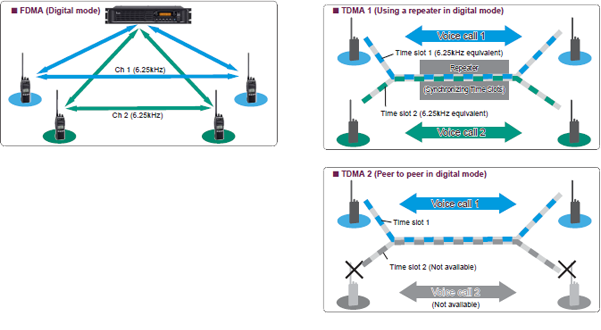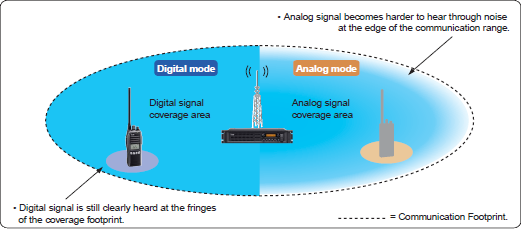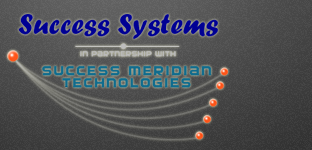Success Systems is the only company that has a Digital Network (IDAS) Covering entire Gauteng and surrounding areas. At this time, three business and industry orientated narrowband digital systems are available. Two of them are based on 6.25kHz FDMA technology (One system also offers 12.5kHz FDMA capability), and one system is based on a 2-slot TDMA modulation scheme operating in a 12.5kHz channel bandwidth. The debate over the merits and demerits of each system will surely arise, but Icom would like to put forward our thoughts on the matter, and clarify certain issues heard to date.
Initial Conclusion: Which System is Better?
This cannot be answered as each system has its merits and demerits. We leave it up to the reader to make any necessary comparisons of each system separately based on publically available information, to make their own decision as to which system best suits their needs.
Clarifying the Facts from the Fiction:
The following is an attempt to give a non-biased explanation about the 6.25kHz FDMA and 12.5kHz TDMA systems. Many of the explanations listed below are clarifications of items relating to the two systems that have appeared in the public domain to date.
The Technology:
Without getting too technical, the basic difference between FDMA (Frequency Divided Multiple Access) and TDMA (Time Divided Multiple Access) is the definition of a channel and how it is used (accessed). In FDMA a particular bandwidth (E.g. 6.25kHz) at a particular frequency (E.g. 150.000MHz) is used to define a channel. Basically, the way channels have been allocated for decades. In TDMA, the same principle applies regarding bandwidth and frequency, but the signal is divided into time slots that allow the channel to have ‘extra’ capacity in the same bandwidth E.g. Two 6.25kHz ‘equivalent’ channels in a 12.5kHz channel. See the diagram below for a graphical explanation.

Until now, TDMA was more spectrum efficient at wider channel spacing’s like 25kHz, as for example, two or three users could access the same bandwidth as one FDMA channel user. However, in the case of the newly developed narrowband 6.25kHz FDMA technology, both this and 2-slot 12.5kHz TDMA technology achieve the same result as far as spectrum efficiency is concerned.
Proprietary or Open Protocols:
The TDMA system protocol is compliant to the open European Telecommunications Standards Institute (ETSI) technical standard TS102 361, commonly known as DMR (Digital Mobile Radio). A license and royalties to use the protocol in product development is required, but in essence, any manufacturer can develop DMR compliant products.
Again, in Europe a license-free version of the 6.25kHz FDMA protocol is available as the ETSI technical standard TS102 490, commonly known as dPMR446. No license or royalties are required to use this protocol, and any manufacturer is free to develop compliant products. The development of a licensed (Tier 2) version of this standard has just recently been approved by ETSI, and completion of the updated standard is expected at the end of 2008.
Outside of Europe, to date the TDMA system has been a single vendor protocol, and as of the writing of this paper, it is not known about the possibility of other manufacturers being able to develop or supply product based on this protocol. Outside of Europe, products compliant to the 6.25kHz FDMA protocol are currently offered by two manufacturers, one of them being Icom. It is expected more manufacturers will eventually offer products based on this protocol. Therefore, the answer as to whether either technology is open or proprietary is a mixed one as you can see.
Spectrum Efficiency and “Double Capacity”:
As explained above, both technologies achieve the same 6.25kHz narrowband capability via different methods. The difference is that the FDMA system is a ‘true’ 6.25kHz channel and the TDMA system provides 6.25kHz channel ‘equivalence’ via the time slots in 12.5kHz bandwidth. From the perspective that 12.5kHz is considered the current narrowband standard channel spacing, then both systems achieve so called “double capacity”. The difference is that the FDMA system is ALWAYS double capacity whether it is used with or without infrastructure. For TDMA, double capacity is ONLY achieved when a repeater is synchronizing the time slots, and that two users are in the same geographical area, accessing the same repeater at the same time. See the diagram below.

Audio Quality:
Much has been said about the improvements in audio quality of digital LMR radios compared to analog FM. Currently, both the FDMA and TDMA systems are utilizing the same vocoder, so apart from any differences in the speaker design or output; both systems’ audio quality would be of a similar level.
Coverage:
In theory, in identical conditions, the narrower channel width of the FDMA system would allow the signal to achieve better coverage than the 12.5kHz TDMA (or FDMA) system when transmitted at the same output power. This is because the noise floor of any receiver is proportional to the filter bandwidth, therefore the smaller the bandwidth the smaller the signals that can be received.
In real world use, various factors such as topography, antenna height of base stations and surrounding buildings etc. all affect coverage, so without specific comparison tests, either system cannot claim to be better than the other. What can be said is that when compared to an analog FM signal, digital easily out-performs analog in audio clarity at the fringes of the communication range, thus providing more reliable audio over a greater total area, even if the coverage footprint is the same as analog FM. See the diagram below for an image.

Battery Life:
The manufacturer of the TDMA system claims 40% improved battery life in digital mode as the radio is transmitting only half the time (I.e. one time slot). While we cannot prove this true or false, to date, we have not been able to find any figures on actual transmit power consumption in public literature to make any accurate judgments on this claim. As such, the user cannot calculate if there really is any improvement in digital mode battery life. As explained in “Coverage”, in the FDMA system, reduced noise components with the narrower channel bandwidth improves receiver sensitivity. Therefore, it is possible to transmit at reduced output power, which in turn conserves battery life and thus can prolong radio use time.
System Costs:
It has been said that the FDMA system is potentially more expensive for licensing costs, and system set up costs (As for example, ‘expensive combining equipment’ or more repeaters are required). Licensing regulations differ between countries and authorities, so it is completely plausible that the two time slots of the TDMA system could be considered ‘individual channels’, and thus the same licensing cost issues would apply.
The argument about total system set up cost depends on a number of factors and/or assumptions like;
- All systems will be new sites or systems only.
One of the aims of Icom’s system is to allow users to migrate their existing analog system to a digital system at their pace. A completely new system is not required. It is expected that a lot of equipment like a combiner will already be in place at an existing site. - FDMA system components are expensive.
The cost of products is an individual business policy of each manufacturer, but Icom intends to supply competitively priced products. Our two channel in one box configuration offers the site owner a flexible way to implement infrastructure at a competitive price advantage.
In the end individual user needs and market trends will determine the outcome of system costs, and again this applies to all three systems
on offer.
Interference Issues:
Due to the narrower bandwidth, concerns about adjacent channel interference have been raised regarding 6.25kHz FDMA early on. Icom has done significant testing and has made presentations to U.S. frequency coordinating authorities to show that interference issues have been taken care of, resulting in the granting of licenses for 6.25kHz channel use. Icom’s FDMA products are also compliant with the European ETSI standard EN301 166 for analog/digital narrowband communications, at the more difficult to comply with 6.25kHz bandwidth.
As the TDMA system products operate in 12.5kHz bandwidth, adjacent channel interference issues are well taken care of, as this has been a requirement for all radio manufacturers for some time at this channel spacing. The evidence is in the same narrowband licenses being approved by U.S. frequency coordinating authorities. The European DMR products are required to comply with EN300 113 which is the equivalent standard for 12.5 kHz systems.
Further monitoring of potential interference issues will need to be continued by all interested parties as product penetration increases in the market. This applies to 6.25kHz FDMA for adjacent channel interference and the TDMA system for example, with co-channel interference (I.e. the time slots interfering each other), which may be an issue when two separate stations are accessing the same repeater from different distances due to differences in the synchronizing timing between the time slots.
Digital Functions:
Both the FDMA and TDMA systems offer a number of functions in both analog and digital modes. A separate comparison of each system by the reader is recommended to obtain better knowledge of which system may suit your requirements, but we will list up what we see as common to both systems for digital features.
- Dual mode capability.
Both systems have analog and digital ‘dual mode’ capability, and compatibility with existing analog FM systems. - Peer to peer communication.
Both systems can communicate peer to peer in digital mode. However, as explained, the 6.25kHz FDMA system will always use only. 6.25kHz of bandwidth per channel in digital mode. As explained in “Spectrum Efficiency and Double Capacity”, the TDMA system will occupy 12.5kHz of bandwidth, but only use half of the channel (I.e. one time slot). From a spectrum efficiency point of view, FDMA has an advantage in peer to peer communication mode. - Signaling and Call type features.
Although the naming may differ between systems, the digital equivalent of individual call, group call, selective call, data calls, status messages etc. exist in both systems to one extent or another - Digital trunking.
At the moment, only one manufacturer has a digital trunking feature available now, but Icom will release trunking capability in the near future. It is not known whether a trunking version of the TDMA system will be released, but a trunking protocol standard exists in the European DMR version of it. - Network interfacing.
Both systems have the capability for networking and/or IP capability, although currently only the TDMA system has offered this functionality for any period of time. It is expected the two FDMA systems will offer this capability in the future. - Applications.
The TDMA system offers a third party application program to add to and enhance the system and its features. Icom also intends to offer third parties the capability to make applications to extend or customize the basic system offering. We do not know about the plans of the other 6.25kHz FDMA manufacturer.
Interoperability:
The minimum requirement for interoperability is the following:
- More than one manufacturer offering a product utilizing a common protocol.
- All manufacturers of such a protocol being compliant with the minimum feature set.
As explained in “Proprietary or Open Protocols:”, in Europe open standards of both the FDMA and TDMA systems exist. Interoperability and conformance test suites also exist so that any manufacturer developing a product correctly based on the respective standard, can be interoperable with another manufacturer’s radio.
Outside of Europe, the two FDMA manufacturers have agreed on and done preliminary testing of a minimum feature set of functions in conventional mode. If and when other manufacturers develop 6.25kHz FDMA products, they would need to have this minimum feature set to be
compliant and thus, interoperable. As mentioned, it is not known if the TDMA manufacturer will make the protocol available to other manufacturers to allow them to make compatible products.
To End:
As shown in this paper, both FDMA and TDMA offer similar advantages and features. We hope that the information provided here has helped clarify any questions you may have had, or given you some new information to reference. It is certainly an exciting time for both manufacturers and users regarding the potential of narrowband digital LMR radio in non-public safety markets around the world.
[tube]http://www.youtube.com/watch?v=iOZuk1qNnKA[/tube]
Download the brochures.
Additional Information
Presentation Notes
RC-FS10 Radio Despatch Software



